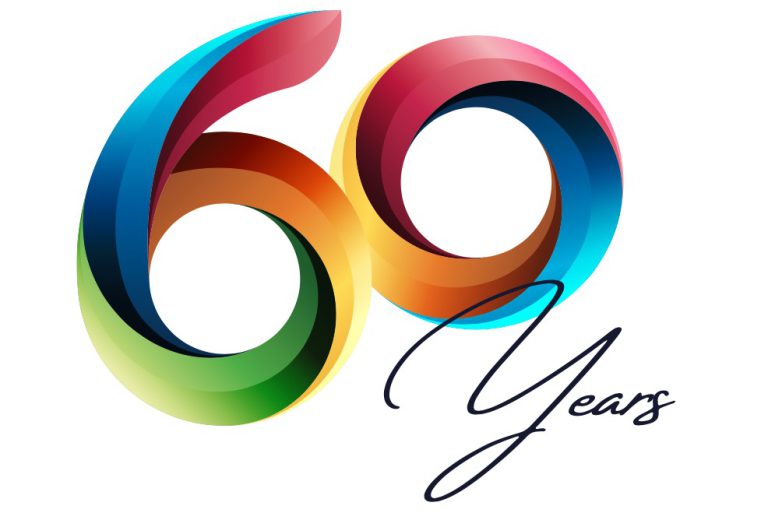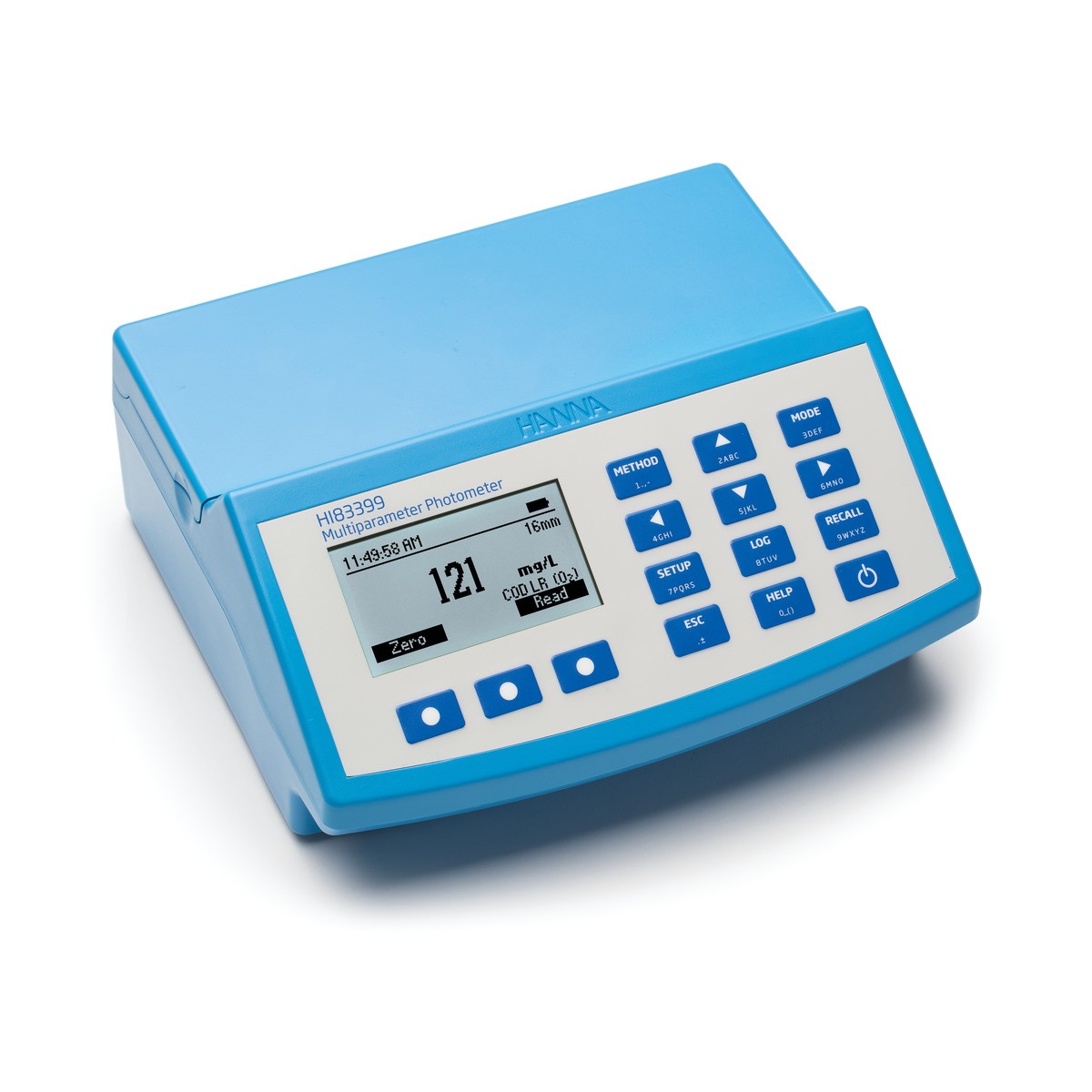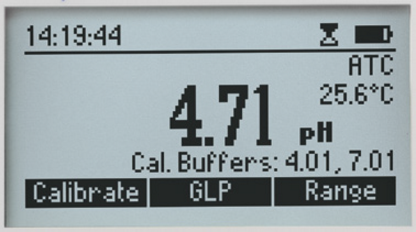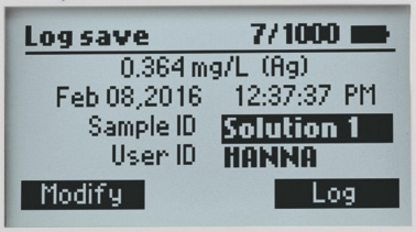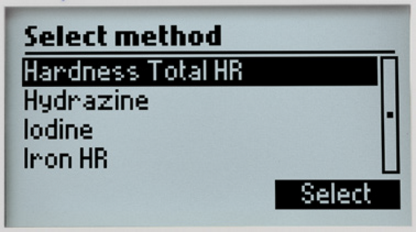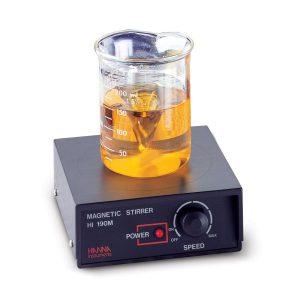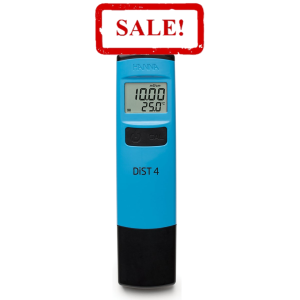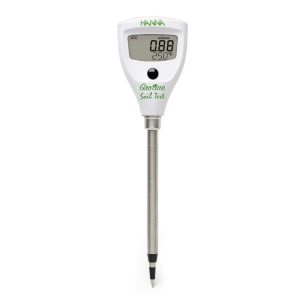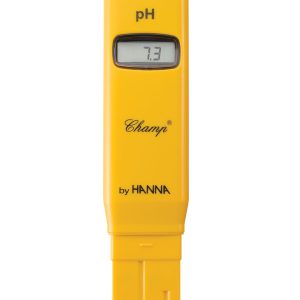תיאור
To save valuable laboratory benchtop space, the HI83399 doubles as a professional pH meter with its digital pH/temperature electrode input. Now one meter can be used for both photometric and pH measurements.
- Advanced optical system
Unparalleled performance from a benchtop photometer
- Digital pH electrode input
Save valuable bench space with one meter that works both as a photometer and as a laboratory pH meter
- Water and Wastewater Treatment Digestion Parameters
Allows measurement of COD, Total Nitrogen and Total Phosphorus
Details
HI83399 benchtop photometer measures 40 different key water and wastewater quality parameters using 73 different methods that allow for multiple ranges and variations in chemistry for specific applications. The Chemical Oxygen Demand (COD) parameter is included for industrial and municipal wastewater treatment. The Phosphorous and Nitrogen parameters included are beneficial to municipal wastewater treatment customers that need to monitor their biological and chemical nutrient removal process. This photometer features an innovative optical system that uses LEDS, narrow band interference filters, focusing lens and both a silicon photodetector for absorbance measurement and a reference detector to maintain a consistent light source ensures accurate and repeatable photometric readings every time.
A digital pH electrode input is provided allowing the user to measure pH by a traditional glass electrode. The digital pH electrode has a built in microchip within the probe that stores all of the calibration information. Having the calibration information stored in the probe allows for hot swapping of pH electrodes without having to recalibrate. All pH measurements are automatically compensated for temperature variations with a built in thermistor located in the tip of the sensing bulb for fast and accurate temperature measurement.
Two USB ports are provided for transferring data to a flash drive or computer and to use as a power source for the meter. For added convenience and portability the meter can also operate on an internal 3.7 VDC Lithium-polymer rechargeable battery.
The HI83399 offers an absorbance measuring mode that allows for CAL Check standards to be used to validate the performance of the system. The absorbance mode allows the user to select one of the 5 wavelengths of light (420 nm, 466 nm, 525 nm, 575 nm, and 610 nm) to measure and plot their own concentration versus absorbance mode. This is useful for users with their own chemical method and for education to teach the concept of absorbance by using the Beer-Lambert Law.
Features/Benefits:
Backlit 128 x 64 Pixel Graphic LCD Display
-
Backlit graphic display allows for easy viewing in low light conditions
- The 128 x 64 Pixel LCD allows for a simplified user interface with virtual keys and on-screen help to guide the user through use of the meter
Built-in Reaction Timer for Photometric Measurements
- The measurement is taken after the countdown timer expires.
- Countdown timer ensures that all readings are taken at the appropriate reaction intervals regardless of user for better consistency in measurements
Absorbance mode
- Hanna's exclusive CAL Check cuvettes for validation of light source and detector
- Allows for the user to plot concentration versus absorbance for a specific wavelength for use with user supplied chemistry or for teaching principles of photometry
Units of Measure
- Appropriate unit of measure along with chemical form is displayed along with reading
Result Conversion
- Automatically convert readings to other chemical forms with the touch of a button
Cuvette Cover
- Aids in preventing stray light from affecting measurements
Digital pH Electrode Input
- Measure pH and temperature with a single probe
- Good Laboratory Practice (GLP) to track calibration information including date, time, buffers used, offset and slope for traceability
- pH CAL Check alerts user to potential problems during the calibration process
- Space saving having a pH meter and photometer built into one meter
Data Logging
- Up to 1000 photometric and pH readings can be stored by simply pressing the dedicated LOG button. Logged readings are just as easily recalled by pressing the RCL button
- Sample ID and User ID information can be added to a logged reading using alphanumeric keypad
Connectivity
- Logged readings can be quickly and easily transferred to a flash drive using the USB-A host port or to a computer using the micro USB-B port
- Data is exported as a .CSV file for use with common spreadsheet programs
Battery Status Indicator
- Indicates the amount of battery life left
Error Messages
- Photometric error messages include no cap, high zero, and standard too low
- pH calibration messages include clean electrode, check buffer and check probe
On-screen Features
Advanced Optical System
HI83300 is designed with an innovative optical system that incorporates a beam splitter so that light can be used for absorbance readings and for a reference detector. The reference detector monitors the intensity of light and modulates when there is drift due to power fluctuation or the heating of the optical components. Each part has an important role in providing unparalleled performance from a photometer.

High Efficiency LED Light Source
An LED light source offers superior performance as compared to a tungsten lamp. LEDs have a much higher luminous efficiency, providing more light while using less power. They also produce very little heat, which could otherwise affect the optical components an electronic stability. LEDs are available in a wide array of wavelengths, whereas tungsten lamps are supposed to be white light (all wavelengths of visible light) but actually have a poor blue/violet light output.
High Quality Narrow Band Interference Filters
The narrow band interference filter not only ensure greater wavelength accuracy (+/- 1 nm) but are extremely efficient. The filters used allow up to 95% of the light from the LED to be transmitted as compared to other filters that are only 75% efficient. The higher efficiency allows for a brighter, stronger light source. The end result is higher measurement stability and less wavelength error.
Reference Detector for a Stable Light Source
A beam splitter is used as part of the internal reference system of the HI83300 photometer. The reference detector compensates for any drift due to power fluctuations or ambient temperature changes. Now you can rely on a stable source of light between your blank (zero) measurement and sample measurement.
Large Cuvette Size
The sample cell of the HI83300 fits a round, glass cuvette with a 25 mm path length. Along with the advanced optical components, the larger size of the cuvette greatly reduces errors in rotation from the indexing mark of the cuvettes. The relatively long path length of the sample cuvette allows the light to pass through more of the sample solution, ensuring accurate measurements even in low absorbance samples.
Focusing Lens for Greater Light Yield
Adding a focusing lens to the optical path allows for the collection of all of the light that exits the cuvette and focusing the light on the silicon photo detector. This novel approach to photometric measurements cancels the errors from imperfections and scratches present in the glass cuvette eliminating the need to index the cuvette.
-
pH Specifications
pH Range Photometer: 6.5 to 8.5 pH
pH electrode: -2.00 to 16.00 pHpH Resolution Photometer: 0.1 pH
pH electrode: 0.1 pHpH Accuracy Photometer: ±0.1 pH
pH electrode: ±0.01 pHpH Calibration Automatic one or two point calibration with one set of standard buffers available (4.01, 6.86, 7.01, 9.18, 10.01) pH Temperature Compensation Automatic (-5.0 to 100.0 oC; 23.0 to 212.0 oF); limits reduced based on the pH electrode used pH CAL Check (electrode diagnostics) clean electrode and check buffer/check probe displayed during calibration pH Method Photometer: phenol red pH-mV Range ±1000 mV pH-mV Resolution 0.1 mV pH-mV Accuracy ±0.2 mV Oxygen, Dissolved Specifications
Oxygen, Dissolved Range 0.0 to 10.0 mg/L (as O2) Oxygen, Dissolved Resolution 0.1 mg/L Oxygen, Dissolved Accuracy ±0.4 mg/L ±3% of reading Oxygen, Dissolved Method Adaptation of the Standard Methods for the Examination of Water and Wastewater, 18th edition, Azide modified Winkler method Absorbance
Absorbance Range 0.000 to 4.000 Abs Absorbance Resolution 0.001 Abs Absorbance Accuracy +/-0.003Abs @ 1.000 Abs Alkalinity
Alkalinity Range Freshwater: 0 to 500 mg/L (as CaCO3)
Seawater: 0 to 500 mg/L (as CaCO3)Alkalinity Resolution 1 mg/L Alkalinity Accuracy ±5 mg/L ±5% of reading Alkalinity Method Colorimetric method Aluminum
Aluminum Range 0.00 to 1.00 mg/L (as Al3+) Aluminum Resolution 0.01 mg/L Aluminum Accuracy ±0.04 mg/L ±4% of reading Aluminum Method Adaptation of the aluminon method Ammonia
Ammonia Range Low Range: 0.00 to 3.00 mg/L
Low Range (16 mm vial): 0.00 to 3.00 mg/L
Medium Range: 0.00 to 10.00 mg/L
High Range: 0.0 to 100.0 mg/L
High Range (16 mm vial): 0.0 to 100.0 mg/L
(all as NH3-N)Ammonia Resolution 0.01 mg/L; 0.1 mg/L Ammonia Accuracy Low Range: ±0.04 mg/L ±4% of reading
Low Range (16 mm vial): ±0.10 mg/L or ±5% of reading
Medium Range: ±0.05 mg/L ±5% of reading
High range: ±0.5 mg/L ±5% of reading
High range (16 mm vial): ±1 mg/L or ±5% of readingAmmonia Method Adaptation of the ASTM Manual of Water and Environmental Technology, D1426-92, Nessler method Anionic
Anionic Surfactants Range 0.00 to 3.50 mg/L (as SDBS) Anionic Surfactants Resolution 0.01 mg/L Anionic Surfactants Accuracy ±0.04 mg/L ±3% of reading Anionic Surfactants Method Adaptation of the USEPA method 425.1 and Standard Methods for the Examination of Water and Wastewater, 20th edition, 5540C, Anionic Surfactants as MBAS. Bromine
Bromine Range 0.00 to 8.00 mg/L (as Br2) Bromine Resolution 0.01 mg/L Bromine Accuracy ±0.08 mg/L ±3% of reading Bromine Method Adaptation of the Standard Methods for the Examination of Water and Wastewater, 18th edition, DPD method. Calcium
Calcium Range Freshwater: 0 to 400 mg/L (as Ca2+)
Seawater: 200 to 600 mg/L (as Ca2+)Calcium Resolution 1 mg/L Calcium Accuracy Freshwater: ±10 mg/L ±5% of reading
Seawater: ±6% of readingCalcium Method Freshwater: Adaptation of the Oxalate method
Seawater: Adaptation of the Zincon methodChemical Oxygen Demand
Chemical Oxygen Demand Range Low Range: 0 to 150 mg/L
Medium Range: 0 to 1500 mg/L
High Range:0 to 15000 mg/LChemical Oxygen Demand Resolution 1 mg/L Chemical Oxygen Demand Accuracy Low Range: ±5 mg/L ±4% of reading
Medium Range: ±15 mg/L ±4% of reading
High Range: ±150 mg/L ±2% of readingChemical Oxygen Demand Method Adaptation of the USEPA 410.4
ISO dichromate methods
Mercury-free dichromate green method (LR & MR); dichromate method (HR)Chloride
Chloride Range 0.0 to 20.0 mg/L (as Cl⁻) Chloride Resolution 0.1 mg/L Chloride Accuracy ±0.5 mg/L ±6% of reading at 25 °C Chlorine Dioxide
Chlorine Dioxide Range 0.00 to 2.00 mg/L (as ClO2) Chlorine Dioxide Resolution 0.01 mg/L Chlorine Dioxide Accuracy ±0.10 mg/L ±5% of reading Chlorine Dioxide Method Adaptation of the Chlorophenol Red method. Chlorine
Free Chlorine Range 0.00 to 5.00 mg/L (as Cl2)
Ultra Low Range: 0.000 to 0.500 mg/L (as Cl2)Free Chlorine Resolution 0.01 mg/L
Ultra Low Range: 0.001 mg/LFree Chlorine Accuracy ±0.03 mg/L ±3% of reading
Ultra Low Range: ±0.020 mg/L ±3% of readingTotal Chlorine Range 0.00 to 5.00 mg/L (as Cl2)
Ultra Low Range: 0.000 to 0.500 mg/L (as Cl2)
Ultra High Range: 0 to 500 mg/L (as Cl2)Total Chlorine Resolution 0.01 mg/L
Ultra Low Range: 0.001 mg/L
Ultra High Range:1 mg/LTotal Chlorine Accuracy ±0.03 mg/L ±3% of reading
Ultra Low Range: ±0.020 mg/L ±3% of reading
Ultra High Range: ±3 mg/L ±3% of readingChlorine Method Adaptation of the EPA 330.5 DPD method
Free Chlorine (ULR) & Total Chlorine (UHR): Adaptation of the Standard Methods for Examination of Water and Wastewater, 20th edition, 4500-ClChromium, Hexavalent
Chromium, Hexavalent Range Low Range: 0 to 300 μg/L (as Cr6+)
High Range: 0 to 1000 μg/L (as Cr6+)Chromium, Hexavalent Resolution 1 μg/L Chromium, Hexavalent Accuracy Low Range: ±1 μg/L ±4% of reading
High Range: ±5 μg/L ±4% of readingChromium, Hexavalent Method Adaptation of the ASTM Manual of Water and Environmental Technology, D1687-92, Diphenylcarbohydrazide method. Color, Water
Color, Water Range 0 to 500 PCU (Platinum Cobalt Units) Color, Water Resolution 1 PCU Color, Water Accuracy ±10 PCU ±5% of reading Color, Water Method Adaptation of the Standard Methods for the Examination of Water and Wastewater, 18th edition, Colorimetric Platinum Cobalt method. Copper
Copper Range Low Range: 0.000 to 1.500 mg/L (as Cu2+)
High range: 0.00 to 5.00 mg/L (as Cu2+)Copper Resolution 0.001 mg/L; 0.01 mg/L Copper Accuracy Low Range: ±0.01 mg/L ±5% of reading
High Range ±0.02 mg/L ±4% of readingCopper Method Adaptation of the EPA bicinchoninate method Cyanuric Acid
Cyanuric Acid Range 0 to 80 mg/L (as CYA) Cyanuric Acid Resolution 1 mg/L Cyanuric Acid Accuracy ±1 mg/L ±15% of reading Cyanuric Acid Method Adaptation of the turbidimetric method Fluoride
Fluoride Range Low Range: 0.00 to 2.00 mg/L (as F–)
High range: 0.0 to 20.0 mg/L (as F–)Fluoride Resolution 0.01 mg/L; 0.1 mg/L Fluoride Accuracy Low Range: ±0.03 mg/L ±3% of reading
High Range: ±0.5 mg/L ±3% of readingFluoride Method Adaptation of the Standard Methods for the Examination of Water and Wastewater, 18th edition, SPADNS method Hardness, Total
Hardness, Total Range Low Range: 0 to 250 mg/L (as CaCO3)
Medium Range: 200 to 500 mg/L (as CaCO3)
High Range: 400 to 750 mg/L (as CaCO3)Hardness, Total Resolution 1 mg/L Hardness, Total Accuracy Low Range: ±5 mg/L ±4% of reading
Medium Range: ±7 mg/L ±3% of reading
High Range: ±10 mg/L ±2% of readingHardness, Total Method Adaptation of the EPA recommended method 130.1 Hardness, Calcium
Hardness, Calcium Range 0.00 to 2.70 mg/L (as CaCO3) Hardness, Calcium Resolution 0.01 mg/L Hardness, Calcium Accuracy ±0.11 mg/L ±5% of reading Hardness, Calcium Method Adaptation of the Standard Methods for the Examination of Water and Wastewater, 18th edition, Calmagite method Hardness, Magnesium
Hardness, Magnesium Range 0.00 to 2.00 mg/L (as CaCO3) Hardness, Magnesium Resolution 0.01 mg/L Hardness, Magnesium Accuracy ±0.11 mg/L ±5% of reading Hardness, Magnesium Method Adaptation of the Standard Methods for the Examination of Water and Wastewater, 18th edition, EDTA Colorimetric method Hydrazine
Hydrazine Range 0 to 400 μg/L (as N2H4) Hydrazine Resolution 1 μg/L Hydrazine Accuracy ±4% of full scale reading Hydrazine Method Adaptation of the ASTM Manual of Water and Environmental Technology, method D1385-88, p-Dimethylaminobenzaldehyde method Iodine
Iodine Range 0.0 to 12.5 mg/L (as I2) Iodine Resolution 0.1 mg/L Iodine Accuracy ±0.1 mg/L ±5% of reading Iodine Method Adaptation of the Standard Methods for the Examination of Water and Wastewater, 18th edition, DPD method Iron
Iron Range Low Range: 0.000 to 1.600 mg/L (as Fe)
High Range: 0.00 to 5.00 mg/L (as Fe)Iron Resolution 0.001 mg/L; 0.01 mg/L Iron Accuracy Low Range: ±0.01 mg/L ±8% of reading
High Range: ±0.04 mg/L ±2% of readingIron Method Low Range: Adaptation of the TPTZ Method
High Range: Adaptation of the EPA Phenanthroline method 315B, for natural and treated watersMagnesium
Magnesium Range 0 to 150 mg/L (as Mg2+) Magnesium Resolution 1 mg/L Magnesium Accuracy ±5 mg/L ±3% of reading Magnesium Method Adaptation of the Calmagite method Manganese
Manganese Range Low Range: 0 to 300 μg/L (as Mn)
High Range: 0.0 to 20.0 (as Mn)Manganese Resolution 1 μg/L; 0.1 mg/L Manganese Accuracy Low Range: ±10 μg/L ±3% of reading
High Range: ±0.2 mg/L ±3% of readingManganese Method Low Range: Adaptation of the PAN Method
High Range: Adaptation of the Standard Methods for the Examination of Water and Wastewater, 18th edition, Periodate methodMolybdenum
Molybdenum Range 0.0 to 40.0 mg/L (as Mo6+) Molybdenum Resolution 0.1 mg/L Molybdenum Accuracy ±0.3 mg/L ±5% of reading Molybdenum Method Adaptation of the mercaptoacetic acid method Nickel
Nickel Range Low Range: 0.000 to 1.000 mg/L (as Ni)
High Range: 0.00 to 7.00 g/L (as Ni)Nickel Resolution 0.001 mg/L; 0.01 g/L Nickel Accuracy Low range: ±0.010 mg/L ±7% of reading
High Range: ±0.07 g/L ±4% of readingNickel Method Low Range: Adaptation of the PAN method
High Range: Adaptation of the photometric methodNitrate
Nitrate Range 0.0 to 30.0 mg/L (as NO3–– N)
16 mm vial: 0.0 to 30.0 mg/L (as NO3–– N)Nitrate Resolution 0.1 mg/L Nitrate Accuracy ±0.5 mg/L ±10% of reading
16 mm vial: ±1.0 mg/L or ±3% of readingNitrate Method Adaptation of the cadmium reduction method
16 mm vial: Chromotropic acid methodNitrite
Nitrite Range Freshwater
Low Range: 0 to 600 μg/L (as NO2–-N)
High Range: 0 to 150 mg/L (as NO2–)
Seawater Ultra Low Range: 0 to 200 μg/L (as NO2–-N)Nitrite Resolution Freshwater: 1 μg/L; 1 mg/L
Seawater: 1 μg/LNitrite Accuracy Freshwater
Low Range: ±20 μg/L ±4% of reading
High Range: ±4 mg/L ±4% of reading
Seawater
±10 μg/L ±4% of readingNitrite Method Low Range and Seawater: Adaptation of the EPA Diazotization method 354.1
High Range: Adaptation of the Ferrous Sulfate methodNitrogen, Total
Nitrogen, Total Range Low Range: 0.0 to 25.0 mg/L (as NO3–-N)
High Range: 0 to 150 mg/L (as N)Nitrogen, Total Resolution 0.1 mg/L; 1 mg/L Nitrogen, Total Accuracy Low Range: ±1.0 mg/L or ±5% of reading
High Range: ±3 mg/L or ±4% of readingNitrogen, Total Method Chromotropic acid method Oxygen, Scavenger
Oxygen, Scavenger Range 0 to 1000 μg/L (as DEHA)
0.00 to 1.50 mg/L (as Carbohydrazide)
0.00 to 2.50 mg/L (as Hydroquinone)
0.00 to 4.50 mg/L (as ISO-ascorbic acid)Oxygen, Scavenger Resolution 1 μg/L (DEHA); 0.01 mg/L Oxygen, Scavenger Accuracy ±5 μg/L ±5% of reading Oxygen, Scavenger Method Adaptation of the iron reduction method Ozone
Ozone Range 0.00 to 2.00 mg/L (as O3) Ozone Resolution 0.01 mg/L Ozone Accuracy ±0.02 mg/L ±3% of reading Ozone Method Colorimetric DPD Method Phosphate
Phosphate Range Freshwater
Low Range: 0.00 to 2.50 mg/L (as PO43-)
High range: 0.0 to 30.0 mg/L(as PO43-)
Seawater Ultra Low Range: 0 to 200 μg/L (as P)Phosphate Resolution Freshwater: 0.01 mg/L; 0.1 mg/L
Seawater: 1 μg/LPhosphate Accuracy Freshwater
Low Range: ±0.04 mg/L ±4% of reading
High Range: ±1 mg/L ±4% of reading
Seawater Ultra Low Range: ±5 μg/L ±5% of readingPhosphate Method Freshwater Low Range: Adaptation of the Ascorbic Acid method
Freshwater High Range and Seawater Ultra Low Range: Adaptation of the Standard Methods for the Examination of Water and Wastewater, 18th edition, Amino Acid methodPhosphorous, Acid Hydrolyzable
Phosphorous, Acid Hydrolyzable Range 0.00 to 1.60 mg/L (as P) Phosphorous, Acid Hydrolyzable Resolution 0.01 mg/L Phosphorous, Acid Hydrolyzable Accuracy ±0.05 mg/L or ±5% of reading Phosphorous, Acid Hydrolyzable Method Adaptation of the EPA method 365.2 and Standard Methods for the Examination of Water and Wastewater, 20th edition, 4500-P E, ascorbic acid method Phosphorous, Reactive
Phosphorous, Reactive Range Low Range: 0.00 to 1.60 mg/L (as P)
High Range: 0.0 to 32.6 mg/L (as P)Phosphorous, Reactive Resolution 0.01 mg/L; 0.1 mg/L Phosphorous, Reactive Accuracy Low Range: ±0.05 mg/L or ±4% of reading
High Range: ±0.5 mg/L or ±4% of readingPhosphorous, Reactive Method Low Range: Adaptation of Standard Methods for the Examination of Water and Wastewater, 20th edition, ascorbic acid method, and EPA method 365.2
High Range: Adaptation of the vanadomolybdophosphoric acid method.Phosphorous, Total
Phosphorous, Total Range Low Range: 0.00 to 1.15 mg/L (as P)
High Range: 0.0 to 32.6 mg/L (as P)Phosphorous, Total Accuracy Low Range: ±0.05 mg/L or ±6% of reading
High Range: ±0.5 mg/L or ±5% of readingPhosphorous, Total Resolution Low Range: 0.01 mg/L; 0.1 mg/L Phosphorous, Total Method Low Range: Adaptation of Standard Methods for the Examination of Water and Wastewater, 20th edition, 4500-P E, ascorbic acid method, and EPA method 365.2
High Range: Adaptation of the vanadomolybdophosphoric acid methodPotassium
Potassium Range 0.0 to 20.0 mg/L (as K) Potassium Resolution 0.1 mg/L Potassium Accuracy ±3.0 mg/L ±7% of reading Potassium Method Adaptation of the Turbidimetric Tetraphenylborate method Silica
Silica Range Low Range: 0.00 to 2.00 mg/L (as SiO2)
High Range: 0 to 200 mg/L (as SiO2)Silica Resolution 0.01 mg/L; 1 mg/L Silica Accuracy Low Range: ±0.03 mg/L ±3% of reading
High Range: ±1 mg/L ±5% of readingSilica Method Low Range: Adaptation of the ASTM Manual of Water and Environmental Technology, D859, Heteropoly Molybdenum Blue method
High Range: Adaptation of the USEPA Method 370.1 and Standard Method 4500-SiO2Silver
Silver Range 0.000 to 1.000 mg/L (as Ag) Silver Resolution 0.001 mg/L Silver Accuracy ±0.020 mg/L ±5% of reading Silver Method Adaptation of the PAN method Sulfate
Sulfate Range 0 to 150 mg/L (as SO42-) Sulfate Resolution 1 mg/L Sulfate Accuracy ±5 mg/L ±3% of reading Sulfate Method Turbidimetric – Sulfate is precipitated with barium chloride crystals Zinc
Zinc Range 0.00 to 3.00 mg/L (as Zn) Zinc Resolution 0.01 mg/L Zinc Accuracy ±0.03 mg/L ±3% of reading Zinc Method Adaptation of the Standard Methods for the Examination of Water and Wastewater, 18th edition, Zincon method General Meter
Input Channels 1 pH electrode input and 5 photometer wavelengths pH Electrode digital pH electrode (not included) Logging Type log on demand with user name and sample ID optional input Logging Memory 1000 readings Connectivity USB-A host for flash drive; micro-USB-B for power and computer connectivity GLP calibration data for connected pH electrode Display 128 x 64 pixel LCD with backlight Battery Type / Life 3.7 VDC Li-polymer rechargeable battery / >500 photometric measurements or 50 hours of continuous pH measurement Power Supply 5 VDC USB 2.0 power adapter with USB-A to micro-USB-B cable (included) Environment 0 to 50.0 oC (32 to 122.0 oF); 0 to 95% RH, non-condensing Dimensions 206 x 177 x 97 mm (8.1 x 7.0 x 3.8") Weight 1.0 kg (2.2 lbs.) Photometer/Colorimeter Light Source 5 LEDs with 420 nm, 466 nm, 525 nm, 575 nm, and 610 nm narrow band interference filters Photometer/Colorimeter Light Detector silicon photodetector Bandpass Filter Bandwidth 8 nm Bandpass Filter Wavelength Accuracy ±1 nm Cuvette Type round, 24.6 mm Number of Methods 128 max. Ordering Information HI83399 is supplied with sample cuvettes and caps (4 ea.), cloth for wiping cuvettes, USB to micro USB cable connector, power adapter and instruction manual.
